WhatsApp Mental Well-Being Features
A new set of features for WhatsApp that helps employees who use WhatsApp for work achieve work/life balance while improving mental wellness.
Design Process
01. Empathize
What's the problem
E-communications for work purposes outside of work hours have been associated with poorer employee recovery from work and increased work-life interference, higher levels of burnout and more health impairments.
Facts
The government in Canada has taken a closer look at the right-to-disconnect concept after France adopted a law in 2016 giving workers the right to turn off their electronic work devices outside of business hours over worries that employees were doing unpaid overtime or being driven to burnout. Ontario has followed suit by passing Bill 27 "the right to disconnect law" in October 2021.
Secondary Research
1) 1 in 3 Canadian workers believes burnout will negatively impact their ability to do their job.
2) 47% of Canadians feel exhausted during a typical workday compared to 39% national average.
3) E-communication hinders workers' ability to recuperate outside of work.
4) "Each time you're you receive reminders of urgent or even far-off tasks for your job, your brain goes into overdrive". This consistent stress can result in anxiety, less rational and more emotional decision making, and burnout.
Is WhatsApp as a form of communication for work contributing to the problem?
I had hypothesized that after-work communication was a cause of great stress and anxiety for many employees, particularly those whose employers chose to use WhatsApp as a default form of communication. I imagined this would be very problematic as WhatsApp is one of the most popular communication apps for typical North Americans to communicate via instant message and it would cause work communication to be mixed in with social communication, and by doing so essentially forcing employees to view work communication at all hours.
I wanted to find a way to confirm if this is seriously a problem worth solving? Does this problem really exist or is it just how I feel about workplaces using WhatsApp?
To begin to answer these questions, I started looking at Twitter posts in regards to workplaces using WhatsApp. Here are just a few Twitter posts that validated that others feel the same way I do about this.
“They’ve taken work to WhatsApp. I hate it now. I’ve actually stopped opening WhatsApp and checking messages of other people just to avoid being seen online?”
Primary Research
I surveyed 7 employees whose employers require them to be connected to work through WhatsApp on their personal phones. I opted for surveys instead of face-to-face or phone interviews as I knew I had a very strong bias and I wanted to steer clear of influencing my interviewees.
Survey Questions:
1) On a scale of 1-10 (1 being never and 10 being frequently) How often do you engage in workplace communication via WhatsApp after your shift?
6/7 reported frequently engaging in workplace communication after their shift.
2) On a scale of 1-10 (1 being positive and 10 being negative) how does WhatsApp workplace communication after hours affect your ability to disconnect from work?
6/7 reported that they feel WhatsApp negatively impacts their ability to disconnect from work.
3) On a scale of 1-10 (1 being happy and 10 being very anxious) how does seeing work messages on WhatsApp after your shift make you feel?
5/7 said seeing work-related communication after they off make them at least somewhat anxious.
4) Has your leader communicated with you more than one hour after the end of your shift in the last 2 weeks?
7/7 reported having their leader communicate with them after their shift in the past 2 weeks.
5) Has WhatsApp being used for work deterred you from using WhatsApp?
3/7 reported having avoided looking at WhatsApp altogether after work to avoid being reminded of work matters on their time off.
02. Define
The Challenge
How might we help people experiencing stress and anxiety related to workplace chatter after-hours improve their mental well-being so that they can manage their workplace communication in a healthy way?
Persona
I created this persona to represent the users who participated in my surveys. I wanted to know who I am problem-solving for and referred back to this persona during the entire design process to ensure I solve the right problems that matter to the target audience.
Kevin is a full-time Sales Consultant from Vancouver, B.C, Canada who wants to build his career in retail management. He often struggles to achieve work-life balance, and it's only gotten worst since the pandemic began. The ever-present work communication through WhatsApp on his personal phone makes it almost impossible for him to disconnect or use WhatsApp socially without being reminded of work.
03. Ideate
Sketches
After creating a mood board for inspiration I sketched multiple variations of each screen from my task flow and selected my favourite elements from each one for my digitized lo-fi prototype. Check out some of my very rough sketches below.
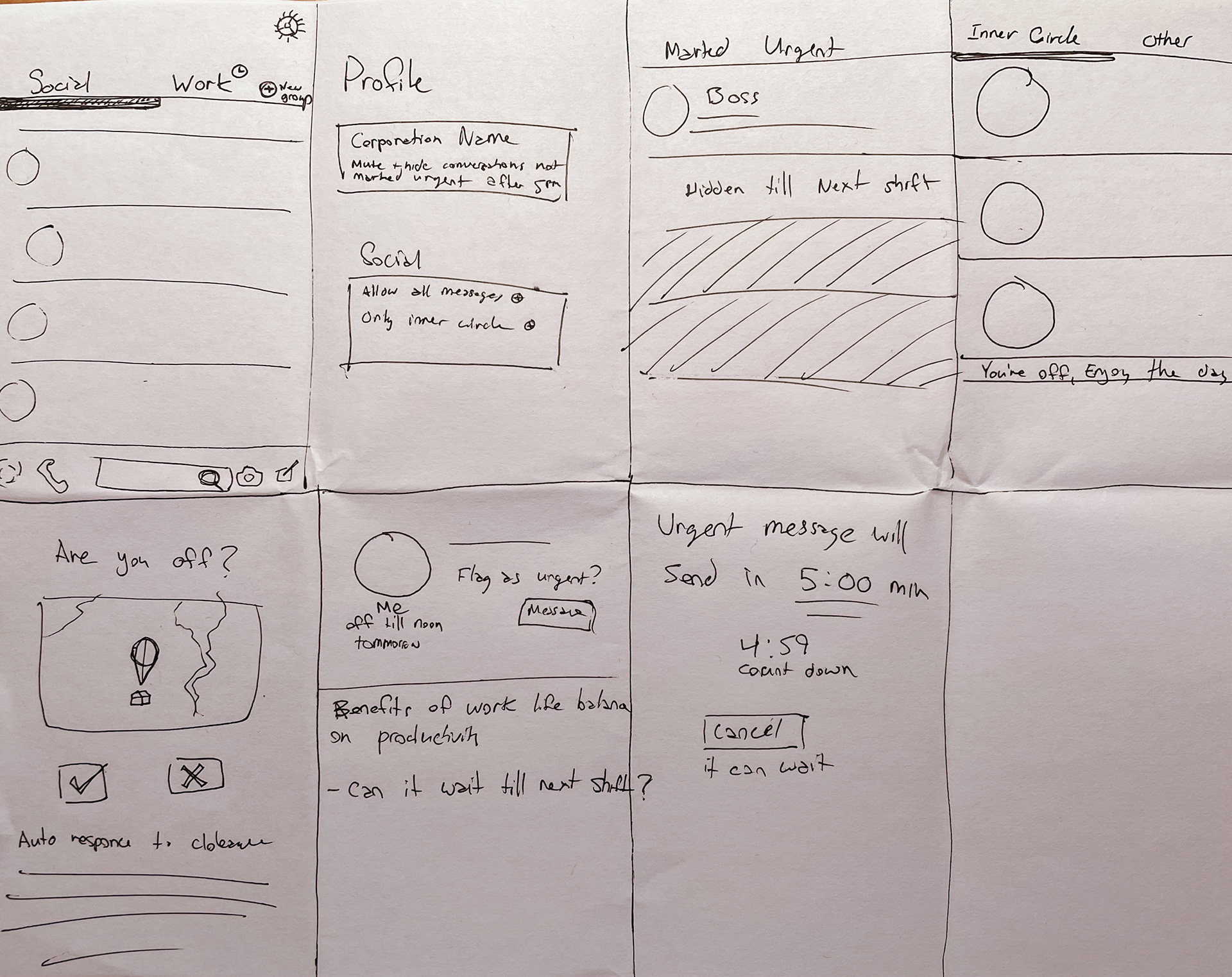

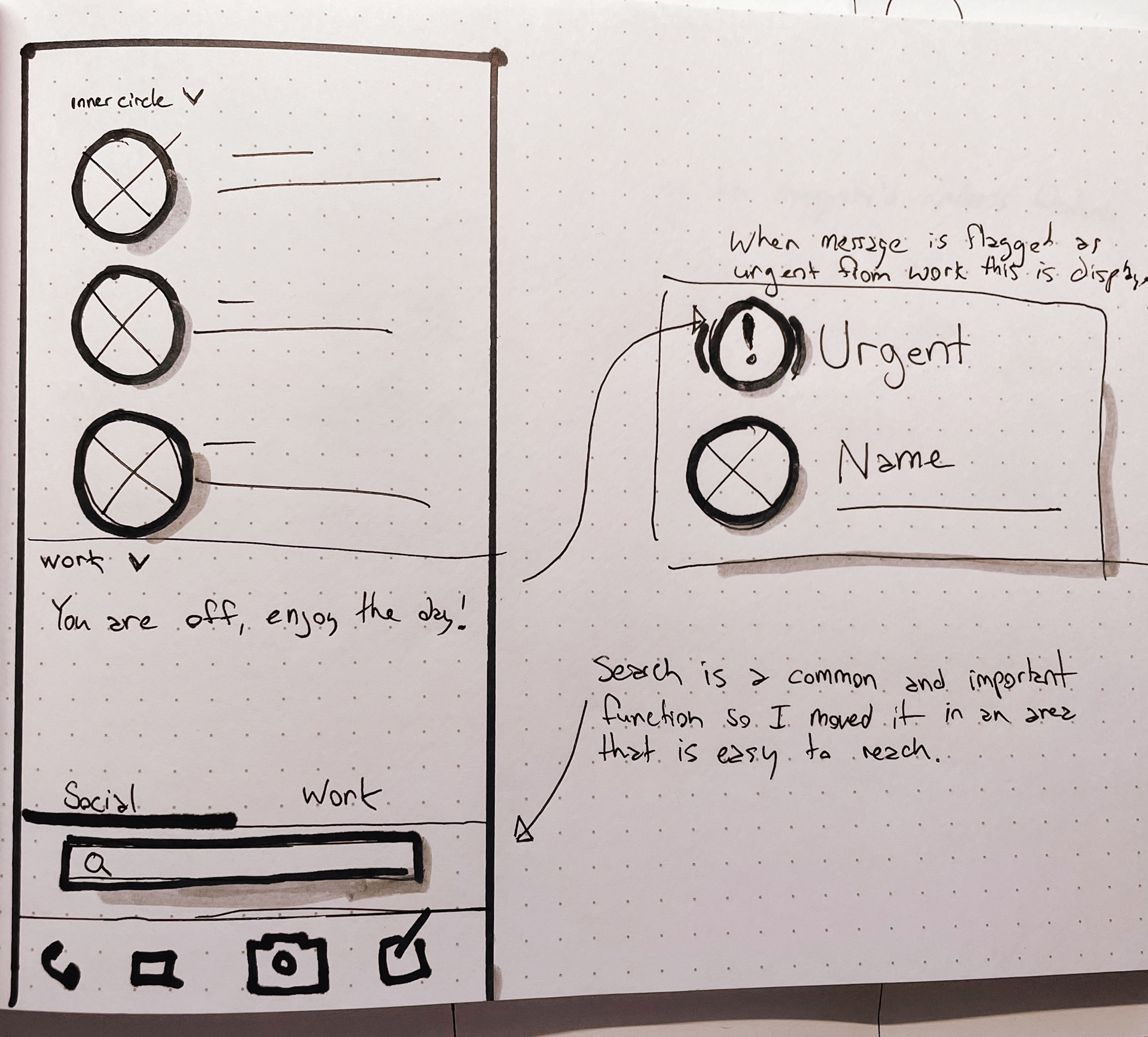
04. Prototype
The Solution
I re-designed WhatsApp to improve employee mental health and guide employers on how to prevent employee burnout.
Heat Map
As part of the redesign, I moved the search bar (a very commonly used function) to a lower placement on the screen to improve reachability and added tabs to differentiate between social chats and work chats.
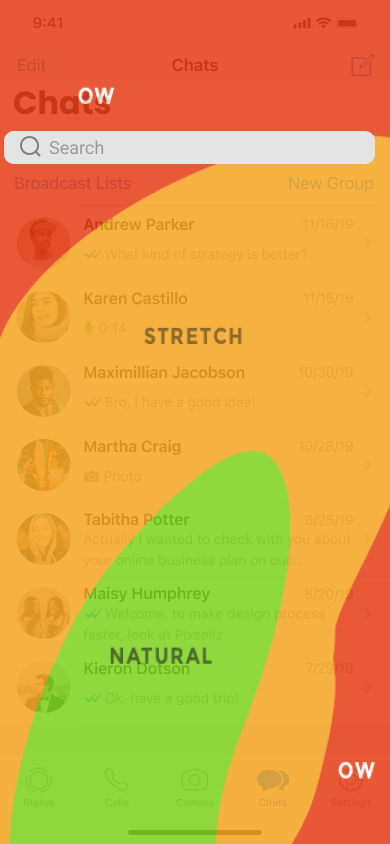
Before

As part of the redesign, I moved the search bar (a very commonly used function) to a lower placement on the screen to improve reachability and added tabs to differentiate between social chats and work chats.
Employee View
I designed a mental wellness feature so that employees can find features that are recommended for helping people manage anxiety-related intrusive communication and social expectations.
In the re-design, you'll see that work messages are hidden and silenced when employees are away from their work location or are done their shift unless messages are flagged as urgent.
Calming Colors
I added an option for a calming colour theme with blue tones which have very calming properties and a sage green that can remind users of nature and impart a sense of relaxation.
Employer View
The stats page provides employers with suggestions to promote employee mental well-being among their teams and rewards them with digital badges to showcase achievements for completing training activities.
In my redesign, when a workplace leader views their employee contact list in WhatsApp it displays the status of if an employee is on shift or done their shift.
Leaders have an option of sending a message to an employee off shift if the message is flagged as urgent and there will be a 5-minute delay for each message to send. This 5-minute delay count down will allow leaders to think critically if the message can wait till the employee's next shift as not to interrupt an employee's personal time. I was inspired to add this feature based on previous experience with being sent messages only to see it be deleted 5 minutes later.
05. Test
Participants
I conducted usability testing with 5 users who were from my family, friends and coworkers. The testing was administered through the Maze.co platform which allowed me to gain insight without the potential of influencing results as I was not present during testing.
Results
This was my first time doing a redesign of an existing app and I was very surprised to not get many errors recorded from the usability test. After looking through the results carefully I hypothesized that this was because all my participants were very familiar with WhatsApp and already had a mental model of how the app should work. Although my redesign brought a few changes to the actual design such as moving the search bar to where it is easier to access, adding an easy way to switch between social and work messages and a couple of additional screens, they generally still followed the mental model users already had for this product.
Insights
The only insight I was able to obtain from my tests suggested that I needed to provide more padding around the stat menu button and increase contrast for some of the smaller text when in the calm colour theme.
6. Iterate
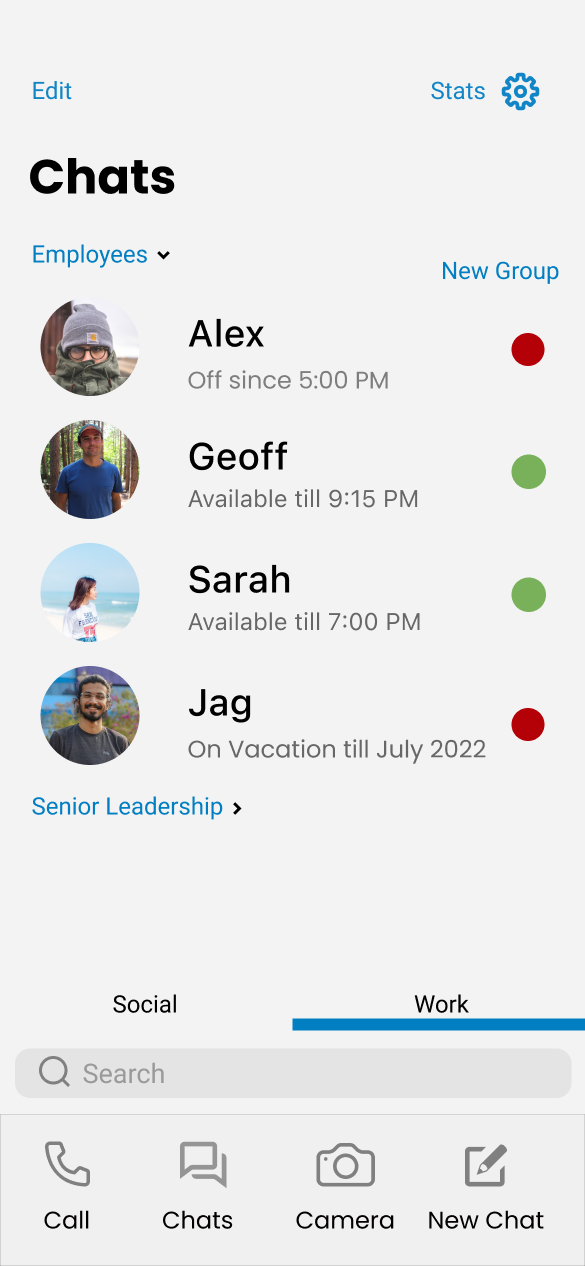
Before
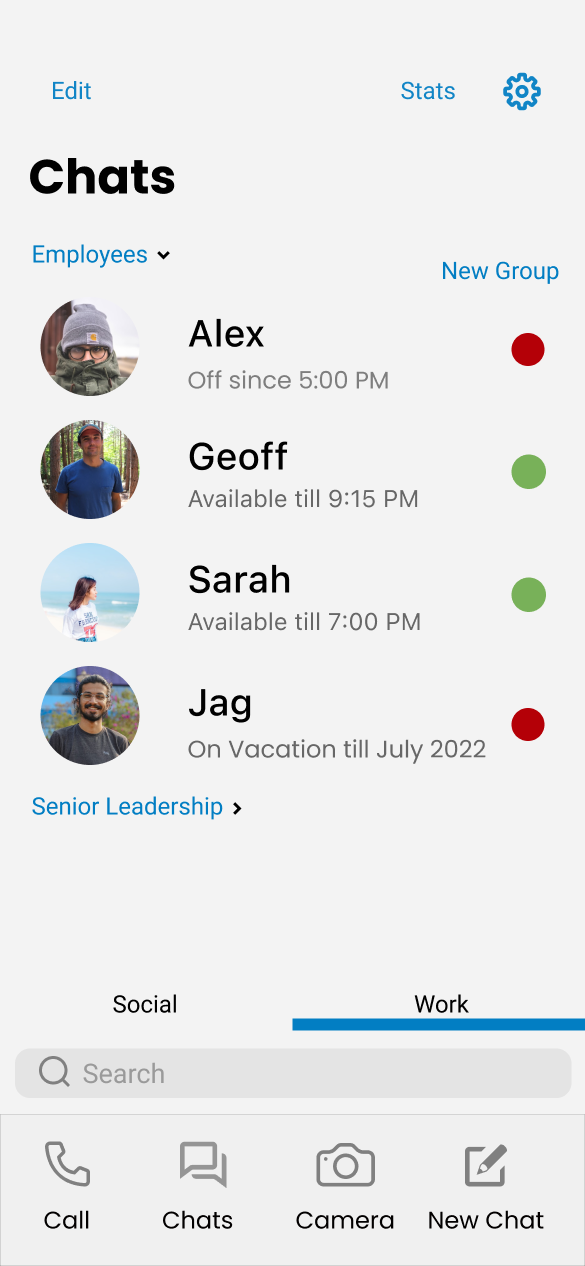
After
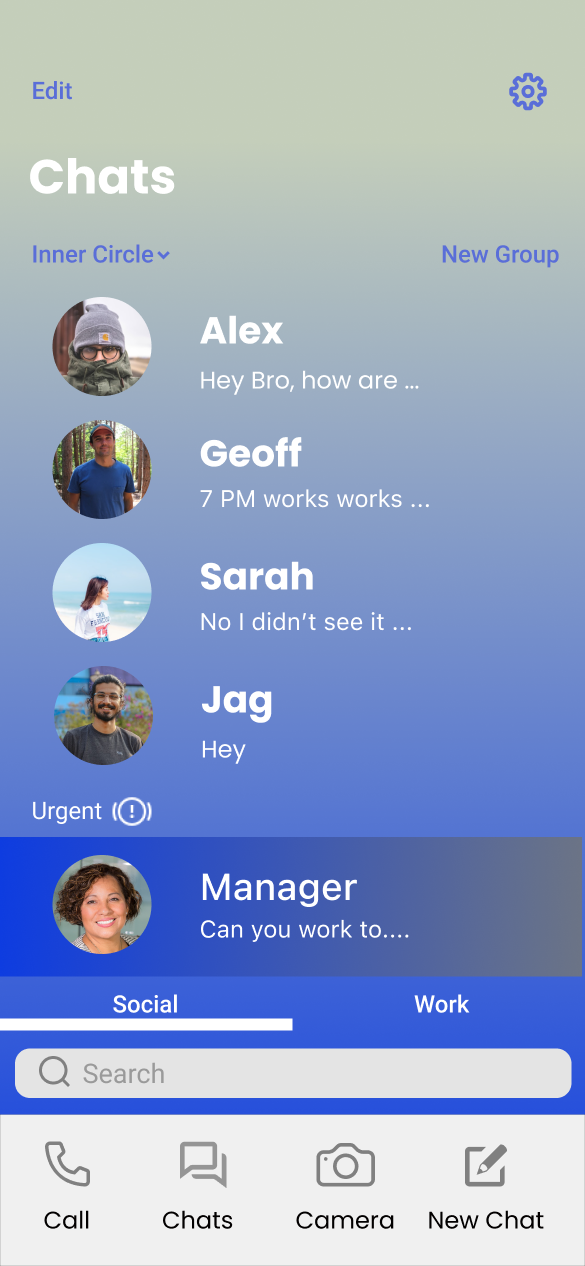
Before
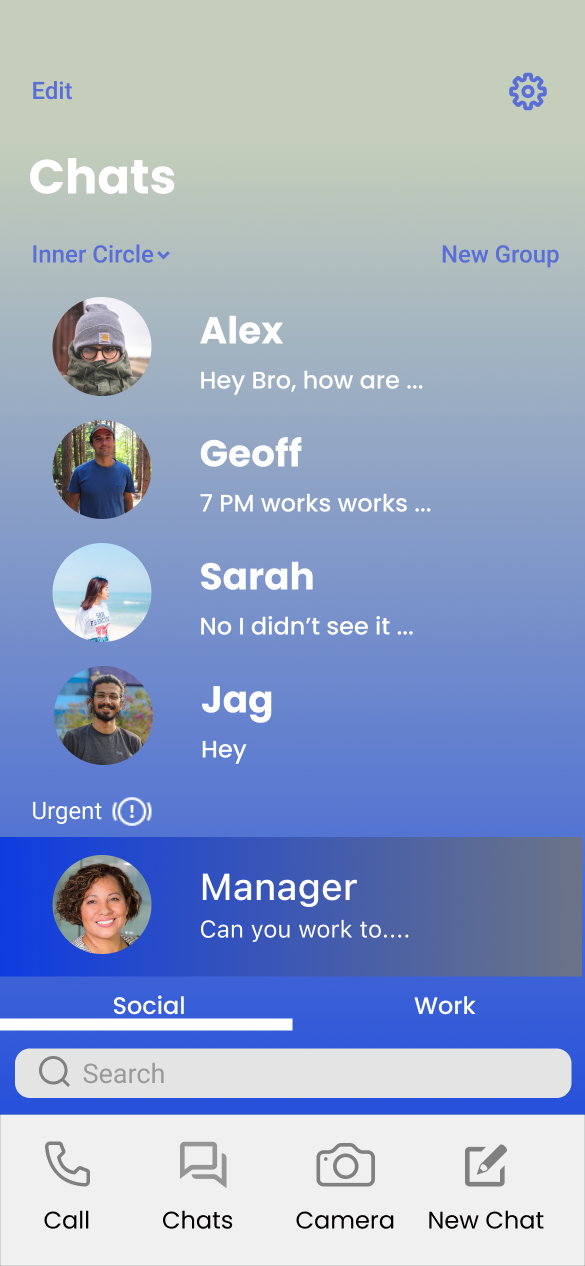
After
In my iteration, I added more spacing between the stats and settings buttons as users were having a hard time selecting the correct one. On the calm colour theme, I added a heavier weight and darker colour to the smallest text to improve readability.
What I have learned
With this project, I learnt to do the bulk of my research at the beginning of the project to ensure I am solving the correct and accurate design problem. I refined my UX research process further and utilized the discovery, explore, test and listen guidelines. With this, I gained a better understanding of how to select my research and testing methods based on different goals and constraints, I also have now had the chance to try multiple research methods and have gotten comfortable with all of them.
One thing I am still curious about is what are the best resources that other UX researchers use to obtain secondary research? I always try and use Google Scholarly Articles as that's what I always used when I was taking research methods in the Psychology B.A program. For this project, I tried using a wider variety of sources including tweets from users with the exact same problem I had hypothesized.
In this project, I also have started getting more comfortable with Figma and even included some simple animations and motion design to give users a more complete experience with my redesign.